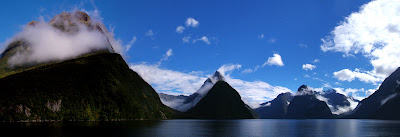28 March - 2 April 2011
Fiordland is a national park that tampers with your sense of scale. Massive rivers rush at a “fast forward” pace, multiple Yosemite-esque valleys spring into view, some of them partially submerged in ocean water, and beech forests cling to sheer cliffs jutting thousands of feet into the air. When it rains, it pours, and in the deluge thousands of waterfalls cascade off cliff faces.
For good reasons, Milford Sound, one of the few easily accessible places in this wilderness-laden park is one of NZ’s most famous tourist attractions. Gazing at Milford Sound from the shoreline you constantly have to remind yourself of the size of the landscape. Each mountain is so big that it is hard to perceive their size. It is hard to imagine that Mitre Peak (in the photo below) rises nearly 6000 feet from the ocean’s surface. Only when a miniature-looking tour boat passes (carrying up to 200 passengers) underneath these peaks do you realize the unbelievable scale of this landscape.
The road to Milford Sound is undeniably one of the most scenic drives in the world. Along the way we stopped to watch the first light on Gunn Lake-admiring dreamy morning reflections. We stopped for a trek up to Kea Summit and gawked at a myriad of peaks and the distant Marian Lake (a lake we hiked to a few days later) perched in a high glacial valley. At the end of the road, staring at postcard-perfect Milford Sound we were greeted by one of the finest views imaginable.
One our second day in Fiordland National Park we took a boat tour in Milford Sound. With the good fortune of clear weather we marveled at impossibly huge mountains, gigantic waterfalls and viewed the “sound” (not really a sound at all, actually a fjord) from the Tasman Sea. From this perspective Miford Sound does not look like much at all. The opening to this fjord is all but imperceptible from the sea. The orientation of Milford’s majestic mountains caused the intrepid explorer Captain James Cook to pass by it twice without notice. Of course, Milford was already well-known to the local Maori as a sacred place and source of coveted jade.
The next day, we scrambled up to Marian Lake, a turquoise gem situated in a high glacial valley. At the start of the trail we traversed a gantry. Adding a new word to our vocabulary we learned that a gantry is a wooden walkway perched above a rushing stream. Along the way we traversed a large landslide that covered a quarter-mile of a hillside. Staring at Marian Lake, dwarfed by mountains and waterfalls, it was not hard to imagine this wild place, not too long ago, cloaked in glacial ice. But back along the gantry…
Milford Sound is place that makes you feel small. It is a landscape that defies ones perception of scale. Just picture multiple Yosemite Valleys (yes more than one of them) filled with water from the ocean. From this perspective it is not hard to imagine why it is a sacred place for the Maori, and has become one of NZ’s most enigmatic places of tourist worship.




